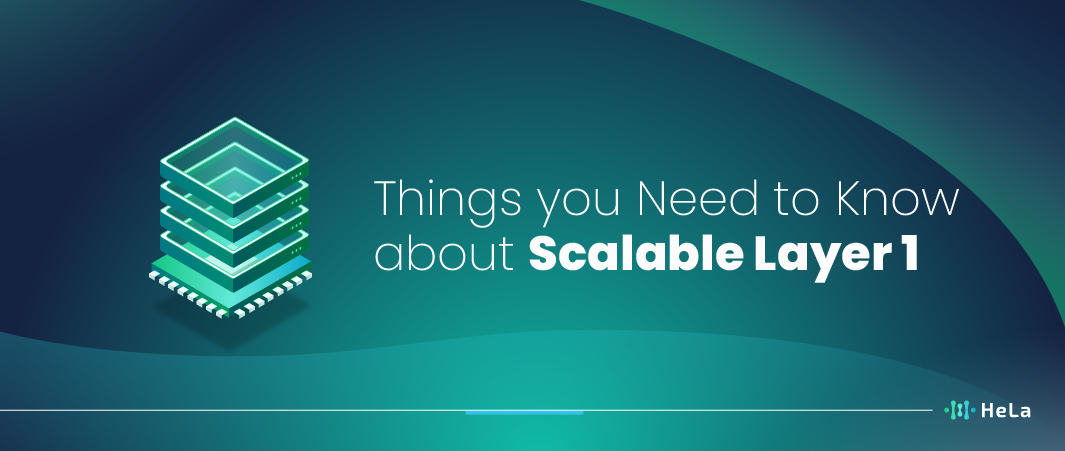In the fast-evolving realm of blockchain technology, the term “scalable layer 1” has emerged as a buzzword among developers, investors, and enthusiasts alike. For those who are unfamiliar, layer 1 refers to the base protocol layer of a blockchain—the very foundation upon which all other activities and applications are built. As blockchain networks grow and demand increases, the need for scalability at this foundational level becomes paramount.
Yet, why is scalability at layer 1 so crucial? The reason is simple. If layer 1 can’t handle a large volume of transactions efficiently, the entire blockchain can become slow, expensive, and unreliable. This not only affects regular transactions but can also hamper the performance of decentralized applications (dApps) and smart contracts. The race is on to create a scalable layer 1 solution that is both secure and efficient.
However, as with all technological advancements, there are challenges. For every innovation in the layer 1 space, there’s a corresponding hurdle to overcome. This article will guide you through the cutting-edge developments in scalable layer 1 solutions and shed light on the challenges these innovations face.
The Essence of Scalable Layer 1 Solutions
Scalable layer 1 solutions focus on making blockchains better at handling lots of transactions while keeping them secure and decentralized. Imagine it’s like upgrading a busy road – you want more traffic to flow without causing accidents or gridlock.
One way to do this is through something called “sharding,” which is like dividing the road into smaller lanes, each handling its own traffic. Each of these lanes is a “scalable layer 1” that can process transactions. Another approach is using clever ways for the computers that maintain the blockchain to agree on what’s valid faster, without cutting corners on safety.
Also Read: Blockchain Adoption: Revolutionizing Transparency
So, scalable layer 1 solutions are like the magic behind making blockchain more powerful, so it can handle a lot more without losing its safety or being too slow. It’s all about making sure that, as more people use blockchain, it keeps working well for everyone.
Pioneering Innovations in Scalable Layer 1

Scalable Layer 1 solutions refer to the foundational layer of blockchain networks, where most of the transaction processing and consensus mechanisms take place. These solutions aim to address the scalability challenges faced by blockchain platforms, such as Bitcoin and Ethereum, which struggle to handle a large number of transactions per second. Several innovative projects have been at the forefront of developing scalable Layer 1 solutions. Here are some of the notable projects and their approaches:
1. HeLa Labs
Hela Labs is proud to introduce Hela, a revolutionary layer-1 blockchain protocol designed to propel Web3 into the mainstream. Despite significant progress in blockchain technology, widespread adoption continues to pose significant hurdles. Hela’s mission is to surmount these challenges by incorporating cutting-edge functionalities that tackle critical issues such as scalability, interoperability, privacy, and user-friendliness.
Key Features of HeLa:
- Scalability: Hela has integrated innovative scaling solutions that enhance transaction throughput and reduce congestion, ensuring the network can handle a massive volume of transactions without compromising efficiency.
- Interoperability: Hela fosters a harmonious coexistence of multiple blockchains by facilitating seamless communication between different networks. This encourages the cross-platform exchange of assets and data.
- Privacy: With a strong emphasis on privacy, Hela incorporates advanced cryptographic techniques to safeguard user data and transaction details, providing a secure and confidential environment for all users.
- User Experience: Hela has redefined the user experience by simplifying complex blockchain operations. Its intuitive design and user-friendly interfaces make it accessible to a broader audience, enabling both novice and experienced users to engage with the technology effortlessly.
By ushering in a new era of decentralized systems, Hela Labs empowers developers and users, creating an ecosystem that fosters innovation and inclusivity. This, in turn, opens the door to seamless integration of blockchain technology with the real world, unlocking a plethora of opportunities for industries and individuals across the globe. Hela is not just a blockchain protocol; it’s a gateway to a future where blockchain is an integral part of everyday life.
2. Ethereum 2.0
Ethereum 2.0 marks a groundbreaking advancement over its predecessor, Ethereum, as it undergoes a transformative shift from the energy-intensive Proof-of-Work (PoW) consensus mechanism to the sustainable and efficient Proof-of-Stake (PoS) protocol. This transition not only signifies a monumental leap in the evolution of layer-1 blockchain technology but also brings about critical enhancements.
Key Features of Ethereum 2.0:
- Proof-of-Stake (PoS): The transition to PoS is the cornerstone of Ethereum 2.0, making the network more environmentally friendly. By ditching energy-intensive mining in favor of staking, Ethereum 2.0 drastically reduces its carbon footprint, aligning with global sustainability initiatives and addressing concerns about the environmental impact of blockchain technology.
- Enhanced Scalability: Ethereum 2.0 is designed to dramatically improve transaction processing capabilities. With PoS, the network can handle a significantly larger number of transactions, facilitating smoother and more efficient operations for users and developers.
- Sharding: Ethereum 2.0 introduces sharding, a technique that partitions the network into smaller segments (shards). This allows for parallel processing of transactions, further enhancing scalability and speeding up the confirmation of transactions.
- Security: PoS doesn’t just save energy; it also enhances security by requiring participants (validators) to lock up a significant amount of cryptocurrency as collateral. This discourages malicious actors and promotes network integrity.
- Economic Incentives: Ethereum 2.0 offers incentives for active participation in the network through staking, creating a dynamic and engaging ecosystem for validators and developers, ultimately strengthening the blockchain.
By embracing the PoS consensus mechanism, Ethereum 2.0 is not only greener but also more efficient and scalable. It represents a crucial step towards a more sustainable and environmentally responsible blockchain future. This upgrade opens the door to a multitude of possibilities and sets the stage for a new era of innovation and development within the Ethereum ecosystem.
3. Polkadot
Polkadot has earned widespread recognition for its exceptional interoperability, a feat achieved through its innovative architectural design. This unique framework empowers the creation of specialized parachains, establishing an ecosystem that places a premium on both scalability and customization. In contrast to conventional blockchain systems, Polkadot’s parachains operate in parallel, fostering seamless communication and data exchange across a multitude of chains.
Key Features of Polkadot’s Design:
- Interoperability: Polkadot’s architecture encourages cross-chain communication, enabling different blockchains and parachains to work together harmoniously. This interoperability extends the capabilities of individual chains and enriches the overall network.
- Parachains: The use of parachains allows for focused and tailored solutions, serving specific purposes within the broader Polkadot network. This modularity promotes versatility and innovation by accommodating various use cases, from decentralized finance to supply chain management.
- Parallel Processing: By running multiple chains in parallel, Polkadot optimizes network efficiency. This parallel processing capability enhances the speed and scalability of the ecosystem, resulting in a smoother and more responsive experience for users and developers.
- Customizability: The ability to create parachains with distinct characteristics and functionalities provides developers with a high degree of flexibility. This encourages the development of specialized solutions and applications tailored to diverse industries and requirements.
- Efficiency and Versatility: Polkadot’s approach embodies the convergence of adaptability and scalability. This positions it as a pioneering platform that sets new standards for efficiency and versatility in the layer-1 blockchain landscape.
In essence, Polkadot’s innovative design has elevated it to a leading position in the blockchain world. It serves as a prime example of how adaptability and scalability can coexist, pushing the boundaries of what’s possible in layer-1 blockchain technology. Polkadot’s commitment to interoperability and customization holds the potential to revolutionize various sectors, making it a trailblazing platform for the development of tailored solutions that cater to the diverse needs of our increasingly interconnected world.
4. Shardeum
Shardeum brings forth an innovative smart contract platform based on the Ethereum Virtual Machine (EVM) that redefines the landscape of blockchain scalability. At the heart of Shardeum’s groundbreaking design is dynamic state sharding, a game-changing approach that prioritizes security and authentic decentralization.
Key Features of Shardeum:
- Dynamic State Sharding: Shardeum’s dynamic state sharding adapts and expands as new validators join the network. This ingenious technique continually enhances the platform’s transactions per second (TPS) capacity while maintaining robust security, all while staying true to the principles of decentralization.
- Low Gas Fees: The scalability achieved by Shardeum leads to low gas fees, making it an attractive choice for users and developers alike. This affordability enhances accessibility and usability, ensuring that the platform remains inclusive.
- Atomic Composability Across Shards: Shardeum’s design enables atomic composability, even across different shards. This is a remarkable feat, as it ensures that smart contracts can interact seamlessly with each other, regardless of the shard they reside on.
- Unmatched Throughput: The combination of dynamic state sharding, low gas fees, and atomic composability results in unparalleled throughput. Shardeum is designed to handle a vast number of transactions efficiently, promising a smooth user experience.
- Innovative Possibilities: By solving the scalability challenge and fostering seamless cross-shard interactions, Shardeum unlocks the potential for pioneering blockchain applications. These applications have the power to transform various industries and significantly impact the decentralized technology landscape.
Shardeum’s EVM-based smart contract platform is a trailblazer in the world of blockchain scalability. Its dynamic state sharding approach addresses the limitations of previous systems, delivering enhanced efficiency, affordability, and innovative possibilities. Shardeum stands at the forefront of decentralized technology, shaping the future with its commitment to scalability, security, and composability.
5. Solana
Solana is celebrated for its remarkable scalability, achieved through a unique fusion of the Proof-of-History (PoH) protocol and a customized iteration of Proof-of-Stake (PoS). This ingenious combination results in exceptional speed and unparalleled throughput, setting Solana apart in the blockchain landscape.
Key Features of Solana’s Design:
- Proof-of-History (PoH): The integration of PoH sets Solana apart. PoH provides an immutable historical record that the network leverages to validate and order transactions seamlessly. This record not only enhances security and consensus but also eliminates the need for resource-intensive synchronization processes, contributing to efficiency and speed.
- Customized Proof-of-Stake (PoS): Solana’s PoS variant complements PoH, creating a hybrid design that accelerates the network’s transaction processing capabilities. PoS enhances security and incentivizes validators to participate actively, contributing to network integrity.
- Unparalleled Throughput: Solana’s innovative approach to consensus and historical record-keeping results in extraordinary throughput. The network is capable of handling a vast number of transactions per second, making it a prime choice for applications and services that demand swift and efficient execution.
- Decentralized Applications: Solana’s speed and scalability open new horizons for decentralized applications. It provides a robust and high-performance platform for developers to build applications that require real-time interactions and near-instant transaction confirmations.
- Resource Efficiency: The elimination of synchronization processes and the network’s high throughput contribute to resource efficiency, reducing the energy consumption associated with blockchain operations.
Solana’s hybrid approach to consensus and historical record-keeping is a game-changer in the blockchain world. It enables remarkable speed, efficiency, and security, making Solana a preferred platform for a wide range of decentralized applications and services. Solana stands as a testament to the ongoing innovation in the blockchain space, pushing the boundaries of what is achievable in terms of scalability and performance.
The Unavoidable Challenges

In the realm of groundbreaking innovation, one must confront and surmount a set of formidable challenges:
Security Concerns
It is an immutable truth that as the complexity of a system grows, so too does the potential for security vulnerabilities. Striving for scalability should never be at the expense of safeguarding the system from malicious threats. The delicate balance between innovation and security must be maintained with utmost care.
Decentralization vs. Efficiency Dilemma
Scalability often presents a conundrum where one must weigh the advantages of efficiency against the principles of decentralization. In the quest for scalability, some solutions might lean towards a reduced number of validators, a decision that can raise concerns about centralization. This trade-off necessitates thoughtful consideration and a commitment to preserving the democratic spirit of blockchain technology.
Interoperability Challenges
As various scalable layer 1 solutions emerge, the imperative to ensure their seamless communication and interoperability cannot be overstated. A harmonious blockchain ecosystem relies on these technologies being able to collaborate effectively, fostering a unified and interconnected digital landscape.
In the relentless pursuit of innovation, these challenges must be acknowledged and addressed with a blend of ingenuity and strategic thinking. Only through such a balanced approach can we propel the world of blockchain and technology to new heights.
The Role of Community and Governance
In addition to technical excellence, the success of a project relies heavily on its community and governance. A robust and engaged community, actively offering feedback, participating in decision-making, and contributing through various roles, plays a pivotal role. As we witness the evolution of scalable layer 1 solutions, the community’s involvement in shaping the project’s direction and decision-making gains even more importance. The trust the community places in the project’s leadership and their effectiveness in governance can truly determine whether a scalable layer 1 solution gains widespread adoption.
Let’s dive a bit deeper into this. The community serves as the lifeblood of a scalable layer 1 project, offering diverse perspectives and insights. It’s not just about having a technically sound solution; it’s about making the community an integral part of the project’s decision-making process. Their active participation ensures that upgrades and directions align with the actual needs of users. If the community feels heard and valued, it fosters a sense of trust and belonging, which is pivotal for the success and scalability of the project. In essence, it’s not just about the code; it’s about the people behind it and their shared vision for the future.
As we move forward in the world of scalable layer 1 solutions, the synergy between community and governance will be a decisive factor. Effective governance, driven by the community’s input, can steer the project in the right direction, making it more appealing and practical for a broader audience. A strong, engaged community isn’t just an added bonus; it’s the key ingredient that can either make or break the adoption of a scalable layer 1 solution.
The Future Outlook: Beyond Scalability

Looking ahead, the future of blockchain technology extends beyond just scalability. While scalability remains a critical concern, our ultimate aim is to establish a blockchain ecosystem that combines scalability, security, decentralization, and user-friendliness. To achieve this, we must look at innovative solutions that go beyond mere expansion. One key element is the development of a scalable layer 1, which forms the foundation for all blockchain operations.
Also Read: Top 6 New Layer 1 Blockchain Promising Projects in 2023
In this evolving landscape, privacy enhancements, flexible smart contracts, and improved energy efficiency will be vital components in shaping the blockchain’s trajectory. Privacy innovations will offer individuals greater control over their personal data and transactions, ensuring that the blockchain can meet diverse privacy needs. Smart contracts, with increased flexibility, will open doors to a wider range of applications, from supply chain management to healthcare, providing users with more options and ease of use. Moreover, focusing on energy efficiency is crucial in the context of environmental concerns, making blockchain technology more sustainable for the long term.
So, as we look forward, it’s not just about making blockchain systems bigger; it’s about making them better, more secure, and accessible to everyone. The future lies in achieving a scalable layer 1, fostering privacy, enabling versatile smart contracts, and optimizing energy usage, all of which will collectively drive the future of blockchain technology.
Conclusion
The journey towards creating a truly scalable layer 1 solution is filled with both exhilarating innovations and formidable challenges. As we stand on the cusp of a blockchain revolution, it’s clear that the path forward requires a delicate balance of technological advancement, community involvement, and robust governance.
Furthermore, the evolution of scalable layer 1 solutions is not an isolated endeavor. It’s intertwined with the broader narrative of blockchain technology striving to reshape industries, empower individuals, and redefine the very essence of trust in the digital age.
As enthusiasts, developers, and stakeholders in this space, our role is not just to witness but actively participate, critique, and contribute to this transformative journey. The future of scalable layer 1 solutions holds promise, but its realization will be a collective endeavor.
Disclaimer: The information provided by HeLa Labs in this article is intended for general informational purposes and does not reflect the company’s opinion. It is not intended as investment advice or recommendations. Readers are strongly advised to conduct their own thorough research and consult with a qualified financial advisor before making any financial decisions.

Joshua Soriano
I am a writer specializing in decentralized systems, digital assets, and Web3 innovation. I develop research-driven explainers, case studies, and thought leadership that connect blockchain infrastructure, smart contract design, and tokenization models to real-world outcomes.
My work focuses on translating complex technical concepts into clear, actionable narratives for builders, businesses, and investors, highlighting transparency, security, and operational efficiency. Each piece blends primary-source research, protocol documentation, and practitioner insights to surface what matters for adoption and risk reduction, helping teams make informed decisions with precise, accessible content.
- Joshua Soriano#molongui-disabled-link
- Joshua Soriano#molongui-disabled-link
- Joshua Soriano#molongui-disabled-link
- Joshua Soriano#molongui-disabled-link

